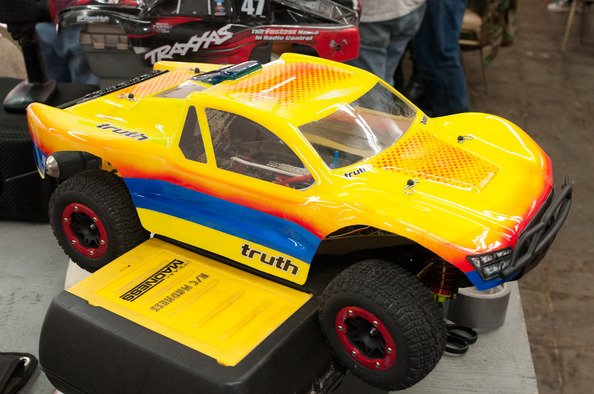The original body for my Traxxas Slash has been in poor condition for quite some time and now has so many cracks in it that it’s literally falling apart. I decided to airbrush a new body. I have previously used an airbrush, but not in quite a few years so I have been practicing before attempting to paint a body. I’ve also never painted a lexan body before — where it’s necessary to paint on the inside of the body, laying paint down in reverse order.
I’ve had an elaborate idea for a paint scheme in mind for quite a while, however after thinking about exactly how to do it I’ve realized that I don’t yet have the skills to execute it. I decided to try a simpler paint scheme first — after all, the original body was falling apart and I really just needed a replacement. This is the simpler paint scheme.
I dove into the paint job and quickly realized a few mistakes, and other mistakes weren’t obvious until I was much further along. This is the first lexan body I’ve ever completed so I feel pretty good about how well it came out; on the other hand I’m a perfectionist and like to think I have some talent and skill with this stuff, so I’m disappointed with the result. In case it helps others, what I’ve learned:
My workshop area is very dirty. I knew it was dirty, of course, but really wasn’t thinking about it when I started painting. The blue stripe is what I painted first and during the process I could see the airbrush catching dust particles and splattering them against the body, creating some weird (and undesired) pucker marks. From now on, I just went outside to paint. Despite leaves and pollen floating by, outside proved a very clean environment to paint in.
Concave surfaces catch a lot of overspray. I masked relatively small areas when I started painting the blue stripe, and as I moved on to other colors I realized that the blue was splattered over much of the body. I tried to clean up what I could see and thought I did a good job. However after backing the body with white and pulling off the body’s blue-tinted protective film I realized just how much overspray there was and how poor a job I did cleaning it off. The solution is simple, of course: mask everything. With large pieces of tape this is easy.
I should have experimented more with color blending and the order in which colors are laid down, and I should slow down more to be sure I’m using the colors in the correct order. I intended the red to be a bit more orange. I should have painted the transparent yellow first, then backed it with red. The red doesn’t look bad, I just wanted more subtlety. Additionally, my hand wasn’t quite steady enough when adding the red fade above the blue so I had to “correct” it by making it thicker than I wanted, which also caused it to cover more area than I intended. More practice and using a guide would let me create a straight and thin line more easily.
When nearly complete I noticed some spots that I think must be fingerprints. When changing masks I’m sure I touched the lexan with my fingertips. I’m not sure if wiping the body after handling it would be enough to remove the marks, or if I should just wear gloves while handling it. The marks left behind are minor, but on a better paint job would stand out more.
In the end, however, I guess it turned out ok because I received a number of compliments and questions about it while at the track last night. The most-asked question was how did I create the red pattern on the hood, roof, and back of the truck. I simply used a router pad as a mask and held it in place while spraying.


Share Your Thoughts (